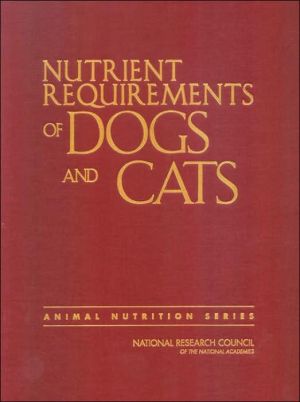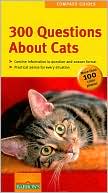Nutrient Requirements of Dogs and Cats:
Updating recommendations last made by the National Research Council in the mid-1980s, this report provides nutrient recommendations based on physical activity and stage in life, major factors that influence nutrient needs. It looks at how nutrients are metabolized in the bodies of dogs and cats, indications of nutrient deficiency, and diseases related to poor nutrition. The report provides a valuable resource for industry professionals formulating diets, scientists setting research agendas,...
Search in google:
Updating recommendations last made by the National Research Council in the mid-1980s, this report provides nutrient recommendations based on physical activity and stage in life, major factors that influence nutrient needs. It looks at how nutrients are metabolized in the bodies of dogs and cats, indications of nutrient deficiency, and diseases related to poor nutrition. The report provides a valuable resource for industry professionals formulating diets, scientists setting research agendas, government officials developing regulations for pet food labeling, and as a university textbook for dog and cat nutrition. It can also guide pet owners feeding decisions for their pets with information on specific nutrient needs, characteristics of different types of pet foods, and factors to consider when feeding cats and dogs.
NUTRIENT REQUIREMENTS OF DOGS AND CATS \ \ NATIONAL ACADEMIES PRESS \ Copyright © 2006 National Academy of Sciences\ All right reserved.\ ISBN: 978-0-309-08628-8\ \ \ \ Chapter One \ Overview\ The National Research Council has published several editions of Nutrient Requirements of Dogs and of Nutrient Requirements of Cats, with the most recent editions published in 1985 and 1986, respectively. This new volume represents a revision of both of the previous reports.\ Nutrient Requirements of Dogs and Cats has used the latest scientific information to provide the requirements for individual nutrients and the scientific basis for the requirements of healthy dogs and cats at several stages of growth and physiological states. The specific nutrients required for normal growth and development and their estimated daily needs have been elucidated in previous editions of the Nutrient Requirements series. This edition contains the latest data on requirements that are based on the utilization of nutrients in ingredients commonly produced and commercially available in dog and cat foods rather than only on purified diets. Because of overlapping use of feed ingredients, as a convenience to readers and for efficient presentation of the scientific basis for nutrient requirements, the Committee on Animal Nutrition recommended combining the dog and cat data that previously had been published separately (National ResearchCouncil, 1985, 1986).\ Nutrient requirement data presented in this report are derived from peer-reviewed literature. An extensive amount of new research conducted since the previous National Research Council publications on dogs and cats was available for this NRC report, yet several gaps still exist in our knowledge of requirements for specific nutrients. These gaps in our knowledge are noted in the text and by the absence of data in the requirement tables. Tables of ingredient composition are provided so that users can select the most common ingredients for the development of diets that provide adequate intake of the required nutrients for optimal growth, maintenance, gestation, and lactation of dogs and cats.\ The report is organized into 15 chapters, each addressing unique aspects of nutrition of dogs and cats, or providing summary tables of requirements and feed ingredients. Each chapter utilizes older well-established literature as well as the new literature published since the last editions of Nutrient Requirements of Dogs (1985) and Nutrient Requirements of Cats (1986). As the committee delved into its task, it became apparent that the committee needed to examine earlier research as well to formalize the boundaries of knowledge for each topic explored in this publication. In some instances, such as digestive physiology and physical activity, the chapters are essentially new additions requiring a thorough review of literature through many decades.\ The committee was also cognizant of the various audiences for this report. The report will be used by professionals in industry and academia for formulating diets and identifying new topics for research. Government officials may use the report as guidance for regulations for pet food labeling. Students and teachers at universities will use the report as a textbook for dog and cat nutrition. Finally, pet owners will use the report in evaluating the feeding decisions for their pets. With these varied audiences, the committee chose to err on the side of caution and include adequate detail from the literature cited to provide a clear roadmap for how the recommendations were derived.\ MINIMAL REQUIREMENT, ADEQUATE INTAKE, RECOMMENDED ALLOWANCE, AND SAFE UPPER LIMIT\ Data on the daily provision of nutrients to dogs and cats are presented in tabular form at the end of this publication. First, the Minimal Requirement is presented and is defined as the minimal concentration or amount of a bioavailable nutrient that will support a defined physiological state. Data on Adequate Intake follow. Adequate Intake is defined as the concentration in the diet or amount required by the animal of a nutrient that is presumed to sustain a given life stage when no Minimal Requirement has been demonstrated. Next, the Recommended Allowance for each nutrient is presented. The Recommended Allowance is defined as the concentration or amount of a nutrient in a diet formulated to support a given physiological state. The Recommended Allowance is based on the Minimal Requirement and, where applicable, includes a bioavailability factor. If no Minimal Requirement is available, the Recommended Allowance is based on the Adequate Intake. Last, data for Safe Upper Limit, or the maximal concentration or amount of a nutrient that has not been associated with adverse effects, are presented.\ As noted in the footnotes to the requirement tables, the following assumptions were made to standardize the tabulated data. The energy density of the diet for both dogs and cats was assumed to be 4,000 kilocalories (kcal) of metabolizable energy (ME) per kilogram (kg). Requirements for growth of puppies are based on a 5.5-kg puppy that consumes 1,000 kcal of ME per day. Requirements for adult dogs at maintenance are based on a 15-kg adult dog that consumes 1,000 kcal of ME per day. Requirements for gestating and lactating dogs are based on a 22-kg bitch with eight puppies in peak lactation consuming 5,000 kcal of ME per day. Requirements for growth of kittens are based on an 800-g kitten consuming 180 kcal of ME per day, and those for an adult cat at maintenance are based on a 4-kg adult cat consuming 250 kcal of ME per day. Requirements for gestating and lactating cats are based on 4-kg queen with four kittens in peak lactation consuming 540 kcal of ME per day.\ For each of the previously mentioned categories of daily nutrient requirement data, units of expression are, in order, (1) amount of nutrient per kilogram of dietary dry matter (DM), which is assumed to contain 4,000 kcal, (2) amount of nutrient per 1,000 kcal of ME, and (3) amount of nutrient per kilogram of body weight to the 0.75 power ([BW.sup.0.75]) for dogs, and per kilogram of body weight to the 0.67 power ([BW.sup.0.67]) for cats. Expressing a requirement relative to DM or ME is most convenient when formulating a diet, but expressing a requirement relative to metabolic body weight may be more convenient when formulating a diet for an individual dog or cat. Unfortunately, requirements expressed relative to DM change with the energy density of the diet, and, in some instances, requirements expressed relative to ME may change with body weight (BW). These changes are illustrated in the introduction to the nutrient requirement tables in Chapter 15.\ Energy requirements are expressed as kcal of ME per kilogram [BW.sup.0.75] per day for dogs at maintenance and for pregnant bitches. For lactating bitches, energy requirements are a function of both [BW.sup.0.75] and BW as well as number of suckling puppies. Daily energy requirements for growing dogs are based on maintenance requirements multiplied by a factor that is a function of the ratio between actual BW and expected mature BW. The equations for energy requirements in dogs are based on data of dogs between 4 and 60 kg of mature weight, except for female reproduction where the majority of data were obtained from dogs between 5 and 25 kg BW. The equations for energy requirements in cats are based on data of domestic cats between 2.5 and 7 kg of mature weight. Energy requirements for cats at maintenance are expressed as kcal of ME per kilogram [BW.sup.0.67] per day for cats with body condition scores equal to or less than 5.0 (on a 9 point scale) and per kilogram [BW.sup.0.4] for cats with body scores greater than 5.0. Energy requirements for pregnant queens are expressed as a function of [BW.sup.0.67], whereas for lactating queens, energy requirements are a function of both [BW.sup.0.67] and BW as well as number of suckling kittens. Daily energy requirements for growing cats are based on maintenance requirements multiplied by a factor that is a function of the ratio between actual BW and expected mature BW.\ REPORT HIGHLIGHTS\ Digestive physiology is examined in Chapter 1. The chapter, which was not previously published in the dog and cat series, includes three components: (1) digestive compartments and functions; (2) hormonal aspects of digestion; and (3) measurement of, and factors affecting, digestibility. This description of each species sets the stage for understanding digestive function and nutritional needs of dogs and cats.\ Chapter 2 addresses feeding behavior of dogs and cats. This new chapter examines intake and factors that affect food and water intake, including aspects of feeding behavior and ingestion that are different in dogs and cats. The chapter includes discussions of how diurnal rhythms, social behavior, dietary deficiencies, and learned taste aversions are involved in feeding behavior such as quantity of food eaten, palatability, and dietary choice.\ A discussion of specific nutrients begins in Chapter 3 with energy. The chapter examines ways to predict energy content of diets. The basis for energy requirement recommendations is explored thoroughly through discussions on the basal metabolic rate, diet-induced thermogenesis, and resting fed metabolic rate for both dogs and cats, leading to energy requirement recommendations for maintenance, growth, pregnancy, and lactation. The chapter concludes with a discussion of energy deficiency and excess including body condition score evaluation.\ The discussion of energy is followed by a detailed description of carbohydrates and fiber in dog and cat nutrition (Chapter 4). This discussion is organized around four types of carbohydrates: (1) absorbable, (2) digestible, (3) fermentable, and (4) nonfermentable carbohydrates. Digestion, absorption, utilization, and nutritive value are explored for each type of carbohydrate. The use of carbohydrates in dog and cat diet formulations ends the chapter.\ Chapter 5 addresses fat and fatty acid (lipid) nutrition with emphasis on the metabolism of the various fatty acid types. This chapter has been updated and expanded to include nomenclature, types and sources of dietary fats, analytical procedures, digestion/absorption of fats, and their digestibility. It also examines the biochemical basis of fatty acid essentiality, describes desaturation and chain elongation pathways, and discusses both structural and functional aspects of dietary lipids. In addition, summaries of studies specifically conducted in dogs and cats with mention of important comparative studies common to other mammalian species also are included. Based on this information, sufficient data are now available to better address the essential nature of both n-6 and n-3 fatty acid types. The chapter culminates with an up-to-date discussion of the requirements, recommendations, and allowances for dogs and cats at their various recognized life stages.\ Chapter 6 addresses protein and amino acid nutrition, with emphasis on differences between dogs and cats in digestibility of protein, bioavailability of key limiting amino acids, and control of protein and amino acid metabolism as it relates to protein and amino acid requirements and dietary choice. A new section has been introduced on the use of plasma amino acids to assess essential amino acid status of the animal. Sufficient data were available to determine that the protein and amino acid requirements of 4- to 14-week-old puppies are higher than those puppies over 14 weeks of age; so, separate requirements for these different age groups are given. The section on taurine has been updated to include information on taurine deficiency-induced dilated cardiomyopathy in the dog and the types of diet that contribute to this problem. Finally, differences between dogs and cats in their responses to amino acid excesses and imbalances are discussed.\ Mineral nutrition is covered and presented in terms of 12 essential macrominerals and trace minerals in Chapter 7. Acid-base balance is explored for mineral metabolism in dogs and cats. Absorption and bioavailability, deficiencies and excesses, and nutrient recommendations are discussed thoroughly for each essential mineral. Additionally, discussion of seven other minerals (arsenic, boron, chromium, molybdenum, silicon, nickel, and vanadium) explores their potential essentiality, although data on the dog and cat currently do not clearly establish them as essential.\ The physiologic functions of 14 fat-soluble and water-soluble vitamins are described in Chapter 8. This discussion includes sections on deficiencies and toxicities for each vitamin. Additional vitamin-like substances, such as inositol, are explored, although none have been demonstrated to be essential for dogs or cats. Finally, vitamin losses in processing and storage of dog and cat foods are examined.\ The physiological and biochemical importance of water is outlined in Chapter 9. Regulation of intake, deficiency, and excess is explored for both dogs and cats. The importance of water and feline urinary tract health is discussed. Special considerations for the nutrition and feeding of dogs and cats as laboratory animals are discussed in Chapter 10.\ Entirely new to this combined revision are the effects of physical activity and the environment on nutrient requirements of dogs and cats in Chapter 11. Starting with dogs as athletes (sled and racing dogs), effects of sprinting and endurances activities on nutrient requirements are explored. The effects of temperature (both high and low) and high altitude (lower oxygen supply) are examined for energy requirements. Nutrient requirements as a function of amount of exercise and ambient temperatures are discussed for water, protein, fats, carbohydrates, minerals, and vitamins.\ The committee presents concepts of diet formulation in Chapter 12. Even though substantial differences in the nutrient requirements of dogs and cats exist, there are many similarities in the techniques used to manufacture their foods. For that reason, petfood processing is addressed in a generic manner and, when appropriate, issues concerning individual species are addressed separately.\ The information provided in Chapter 13 on food composition, food processing, and other food constituents is expanded greatly in this volume. Data in Tables 13-1 through 13-8 were compiled from commercial food ingredient suppliers, published literature, and unpublished data provided by university researchers. The tables include means and, when available, the standard deviation and number (N) of samples used to generate those statistics. Users should examine the standard deviation and N when considering using the mean value as an estimate of the nutritional content of a specific food ingredient. Obviously, means derived from a large N will better reflect the total population. Means with a large standard deviation may represent the total population but may be a poor estimate for a specific sample.\ Chapter 14 presents an overview of other food constituents that may be used in cat and dog diet formulation. These substances in the diet may affect the structure or function of the body but their absence from the diet does not fit into classical models of nutritional deficiency. Some play vital roles in the normal metabolism of the animal but cannot be deemed essential because the body is capable of synthesizing them from other dietary components. Other substances that may play a role in the normal function of the body must come from an exogenous source, but determinations of essentiality have yet to be established. Chapter 14 also presents an overview of other food constituents intended for technical purposes, such as preservatives.\ Nutrient requirements for growth, adult maintenance, gestation, and lactation for dogs and cats are provided in Tables 15-2 through 15-14 (Chapter 15). Estimates are listed for energy, protein and amino acids, fatty acids, macrominerals, trace minerals, and vitamins.\ (Continues...)\ \ \ \ \ Excerpted from NUTRIENT REQUIREMENTS OF DOGS AND CATS Copyright © 2006 by National Academy of Sciences. Excerpted by permission.\ All rights reserved. No part of this excerpt may be reproduced or reprinted without permission in writing from the publisher.\ Excerpts are provided by Dial-A-Book Inc. solely for the personal use of visitors to this web site. \ \
1Comparative digestive physiology of dogs and cats52Feeding behaviour of dogs and cats223Energy284Carbohydrates and fiber495Fat and fatty acids816Protein and amino acids1117Minerals1458Vitamins1939Water24610Special considerations for laboratory animals25211Physical activity and environment25812Diet formulation and feed processing31313Nutrient composition of ingredients used in dog and cat foods31914Other food constituents34415Nutrient requirements and dietary nutrient concentrations354








